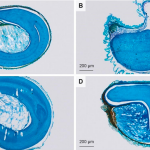Plant Science Research Weekly: Feb 26, 2021
Review: Plant evolution driven by interactions with symbiotic and pathogenic microbes
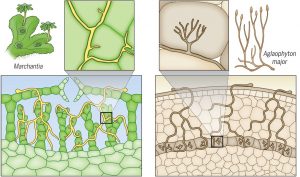 One of the great questions in plant science has been, “How do plants recognize friend from foe?” Like most great questions, this one benefits from a historical perspective. In their new review, Delaux and Schornack look at plant evolution through the lens of plant interactions with symbiotic and pathogenic microbes. The first part of this comprehensive review covers the molecular underpinnings of plant-pathogen and plant-symbiont interactions, drawing on genomic data from the many available genomes from across the green lineage. Arbuscular mycorrhiza symbiosis is the most ancient plant intracellular symbiosis, and widely considered to have been crucial to enable plants to colonize land. Intercellular symbioses, in which cyanobacteria or fungi live between cells, has arisen repeatedly, but without a conserved molecular foundation. Although some plant-microbe genes are ancient and conserved, there are also many examples of convergent evolution in plant-microbe interactions. This review is an excellent update and resource. (Summary by Mary Williams @PlantTeaching) Science 10.1126/science.aba6605
One of the great questions in plant science has been, “How do plants recognize friend from foe?” Like most great questions, this one benefits from a historical perspective. In their new review, Delaux and Schornack look at plant evolution through the lens of plant interactions with symbiotic and pathogenic microbes. The first part of this comprehensive review covers the molecular underpinnings of plant-pathogen and plant-symbiont interactions, drawing on genomic data from the many available genomes from across the green lineage. Arbuscular mycorrhiza symbiosis is the most ancient plant intracellular symbiosis, and widely considered to have been crucial to enable plants to colonize land. Intercellular symbioses, in which cyanobacteria or fungi live between cells, has arisen repeatedly, but without a conserved molecular foundation. Although some plant-microbe genes are ancient and conserved, there are also many examples of convergent evolution in plant-microbe interactions. This review is an excellent update and resource. (Summary by Mary Williams @PlantTeaching) Science 10.1126/science.aba6605
CO2 diffusion in tobacco: a link between mesophyll conductance and leaf anatomy
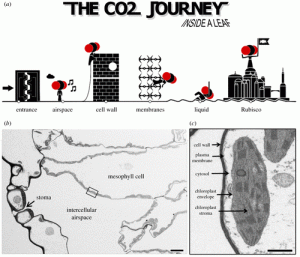 Three key factors affect a plant’s ability to fix carbon: enzymatic activity of Rubisco, stomatal conductance, and the journey from sub-stomatal cavity to Rubisco, also known as mesophyll conductance (gm). This latter is the focus of this new work by Clarke et al. They delightfully compare this journey to that of Princess Leia from Star Wars (see the adjoining illustration; the CO2 molecule works surprisingly well as her head and hair). Here, the authors address how leaf age and leaf position in the canopy affect gm, with the objective of improving models of photosynthesis. To do this, they measured carbon isotope discrimination, gas exchange, Rubisco activity, and leaf anatomy. They found that gm decreases with leaf age, which can largely be attributed to a corresponding increase in cell wall thickness and a decrease in exposure of chloroplasts to intercellular airspace. (Summary by Mary Williams @PlantTeaching) Interface Focus 10.1098/rsfs.2020.0040
Three key factors affect a plant’s ability to fix carbon: enzymatic activity of Rubisco, stomatal conductance, and the journey from sub-stomatal cavity to Rubisco, also known as mesophyll conductance (gm). This latter is the focus of this new work by Clarke et al. They delightfully compare this journey to that of Princess Leia from Star Wars (see the adjoining illustration; the CO2 molecule works surprisingly well as her head and hair). Here, the authors address how leaf age and leaf position in the canopy affect gm, with the objective of improving models of photosynthesis. To do this, they measured carbon isotope discrimination, gas exchange, Rubisco activity, and leaf anatomy. They found that gm decreases with leaf age, which can largely be attributed to a corresponding increase in cell wall thickness and a decrease in exposure of chloroplasts to intercellular airspace. (Summary by Mary Williams @PlantTeaching) Interface Focus 10.1098/rsfs.2020.0040
Multi-omics analysis reveals interplay between BR and TORC signaling
 Plants have evolved well-coordinated crosstalk between different signaling pathways to respond and adapt to various environmental stresses. Brassinosteriods (BRs) and Target of Rapamycin Complex (TORC) have multiple roles, through transcription, translation and autophagy, to control the balance between plant growth and stress response. Montes et al. performed a comprehensive multi-omics analysis (transcriptome, proteome and phosphoproteome) of changes that occur in mutants with altered levels of BIN2 (Brassinosteriod-insensitive 2, a GSK3-like kinase) and the TORC subunit RAPTOR1B. They found BIN2 and RAPTOR1B regulate a common core set of gene products related to growth and stress responses. By employing Multiplexed Assay of Kinase Specificity (MAKS), they identified a proteome-wide view of BIN2 direct targets. The phosphoproteomics data was used to reconstruct the molecular relationships of BIN2 and TORC pathways to predict BR- and TORC-regulated genes. Mutants of 42 predicted genes were assayed and 26 showed a significant response to BR and/or altered level of autophagy. (Summary by Min May Wong @wongminmay) bioRxiv 10.1101/2021.02.12.431003
Plants have evolved well-coordinated crosstalk between different signaling pathways to respond and adapt to various environmental stresses. Brassinosteriods (BRs) and Target of Rapamycin Complex (TORC) have multiple roles, through transcription, translation and autophagy, to control the balance between plant growth and stress response. Montes et al. performed a comprehensive multi-omics analysis (transcriptome, proteome and phosphoproteome) of changes that occur in mutants with altered levels of BIN2 (Brassinosteriod-insensitive 2, a GSK3-like kinase) and the TORC subunit RAPTOR1B. They found BIN2 and RAPTOR1B regulate a common core set of gene products related to growth and stress responses. By employing Multiplexed Assay of Kinase Specificity (MAKS), they identified a proteome-wide view of BIN2 direct targets. The phosphoproteomics data was used to reconstruct the molecular relationships of BIN2 and TORC pathways to predict BR- and TORC-regulated genes. Mutants of 42 predicted genes were assayed and 26 showed a significant response to BR and/or altered level of autophagy. (Summary by Min May Wong @wongminmay) bioRxiv 10.1101/2021.02.12.431003
Differential biosynthesis and cellular permeability explain longitudinal gibberellin gradients in growing roots
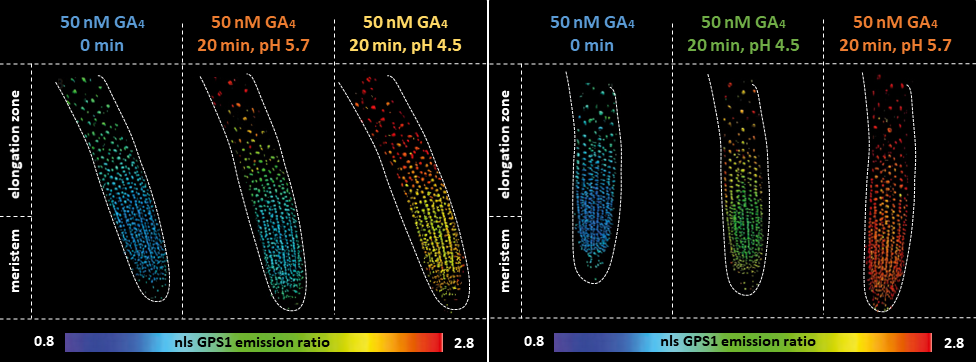 Gibberellin (GA) controls multiple developmental processes throughout the plant life cycle, from seed germination to flowering. In Arabidopsis, GA also regulates division of meristematic cells at the tip of the root and cell elongation in the growing zone. Despite its importance, little is known about the events that generate the GA gradient that drives growth patterning in below-ground organs. In a previous report, Rizza and coworkers employed a nuclear-localized Gibberellin Perception Sensor (nlsGPS1) to map the GA gradient in vivo and found a positive correlation between GA accumulation and cell length in roots (e.g., low GA levels in meristematic cells and high GA levels in elongating cells). In this paper, the authors combined mathematical modeling and live-imaging techniques to monitor GA distribution in different genetic backgrounds, including GA-deficient mutants. The longitudinal gradient of endogenous GA in developing roots mirrored differential GA production, which is related to higher abundance of the precursor GA12 and expression of GA biosynthetic genes in the elongation zone. On the other hand, the gradient generated by exogenous GA reflected differential cellular permeability, which is lower in meristematic cells and higher in elongating cells. Interestingly, pH alteration modified the distribution of exogenous GA – with faster GA accumulation in the elongation zone at pH 5.7 but in the meristematic zone at pH 4.5 – suggesting a correlation between cell elongation and apoplast acidification along the growing root. (Summary and image adaptation by Michela Osnato @michela_osnato). Proc. Natl. Acad. Sci. USA 10.1073/pnas.1921960118
Gibberellin (GA) controls multiple developmental processes throughout the plant life cycle, from seed germination to flowering. In Arabidopsis, GA also regulates division of meristematic cells at the tip of the root and cell elongation in the growing zone. Despite its importance, little is known about the events that generate the GA gradient that drives growth patterning in below-ground organs. In a previous report, Rizza and coworkers employed a nuclear-localized Gibberellin Perception Sensor (nlsGPS1) to map the GA gradient in vivo and found a positive correlation between GA accumulation and cell length in roots (e.g., low GA levels in meristematic cells and high GA levels in elongating cells). In this paper, the authors combined mathematical modeling and live-imaging techniques to monitor GA distribution in different genetic backgrounds, including GA-deficient mutants. The longitudinal gradient of endogenous GA in developing roots mirrored differential GA production, which is related to higher abundance of the precursor GA12 and expression of GA biosynthetic genes in the elongation zone. On the other hand, the gradient generated by exogenous GA reflected differential cellular permeability, which is lower in meristematic cells and higher in elongating cells. Interestingly, pH alteration modified the distribution of exogenous GA – with faster GA accumulation in the elongation zone at pH 5.7 but in the meristematic zone at pH 4.5 – suggesting a correlation between cell elongation and apoplast acidification along the growing root. (Summary and image adaptation by Michela Osnato @michela_osnato). Proc. Natl. Acad. Sci. USA 10.1073/pnas.1921960118
Measuring the physical-chemical effects of osmotic stress in living cells
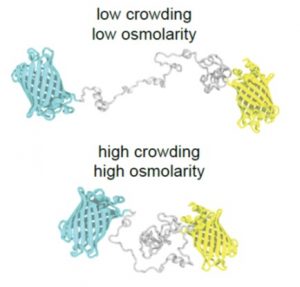 The osmotic state of a cell is affected by internal (metabolite content) and external (water availability) factors. Recent work by Cuevas-Velazquez and colleagues describes the design of a FRET-based biosensor that allows dynamic monitoring of osmotic stress in living cells. They exploited features of AtLEA4-5, an intrinsically disordered protein (IDP) from Arabidopsis. AtLEA4-5 is highly sensitive to the cell’s osmotic state: it is less compact when the osmolarity is low, and highly compact when osmolarity increases; with greater compaction, energy is transferred between fluorescent proteins at either end of the sensor. In this study, AtLEA4-5 was fused to a pair of donor/acceptor fluorescent proteins to generate SED1 (SENSOR EXPRESSING DISORDERED PROTEIN 1; sed means thirst in Spanish). When tested in yeast, the FRET ratio (acceptor to donor emission; DxAm/DxDm) correlates with osmotic stress in a non-osmolyte-specific manner. The authors characterized the sensor in yeast by monitoring the cells’ recovery and responses to this stress. SED1 can be used in organisms such as Escherichia coli, Nicotiana, and human cells. Further studies will focus on modifying the sensor to have broader use in plants. The authors expect the use of SED1 to reveal new fundamental aspects of the osmotic stress response, which would benefit our understanding of desiccation survival, salinity tolerance, and rehydration. (Summary by Humberto Herrera-Ubaldo @herrera_h) bioRxiv 10.1101/2021.02.17.431712
The osmotic state of a cell is affected by internal (metabolite content) and external (water availability) factors. Recent work by Cuevas-Velazquez and colleagues describes the design of a FRET-based biosensor that allows dynamic monitoring of osmotic stress in living cells. They exploited features of AtLEA4-5, an intrinsically disordered protein (IDP) from Arabidopsis. AtLEA4-5 is highly sensitive to the cell’s osmotic state: it is less compact when the osmolarity is low, and highly compact when osmolarity increases; with greater compaction, energy is transferred between fluorescent proteins at either end of the sensor. In this study, AtLEA4-5 was fused to a pair of donor/acceptor fluorescent proteins to generate SED1 (SENSOR EXPRESSING DISORDERED PROTEIN 1; sed means thirst in Spanish). When tested in yeast, the FRET ratio (acceptor to donor emission; DxAm/DxDm) correlates with osmotic stress in a non-osmolyte-specific manner. The authors characterized the sensor in yeast by monitoring the cells’ recovery and responses to this stress. SED1 can be used in organisms such as Escherichia coli, Nicotiana, and human cells. Further studies will focus on modifying the sensor to have broader use in plants. The authors expect the use of SED1 to reveal new fundamental aspects of the osmotic stress response, which would benefit our understanding of desiccation survival, salinity tolerance, and rehydration. (Summary by Humberto Herrera-Ubaldo @herrera_h) bioRxiv 10.1101/2021.02.17.431712
Evolution and ecology of seed internal morphology in relation to germination characteristics in Amaranthaceae ($)
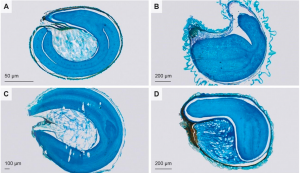 Seed germination, a critical life stage in a plant’s life cycle, can be affected by internal seed morphology. In this exciting research, Vandelook and colleagues investigated the evolution of embryo and nutritive tissue characteristics and their relationship with the germination traits of 84 species of Amaranthaceae, a large and diverse family that includes many plants adapted to harsh environments. Four embryo types were found, with the annular (ring-shaped) one the most common, probably representing the family’s ancestral character state. Embryo type and embryo- to-seed size ratio showed a significant phylogenetic signal, meaning related species tend to be similar in these traits. Interestingly, embryo-to-seed size ratio was associated with species habitats and physiology, with higher proportions found in species from saline environments and with C4 photosynthesis. Moreover, in these species, seeds with relatively larger embryos and reduced nutritive tissue germinated faster, suggesting the importance of embryo size for germination under stressful conditions. This study highlights the relevance of internal seed morphological traits for the evolution of seed germination strategies. (Summary by Carlos A. Ordóñez-Parra @caordonezparra) Ann Bot. 10.1093/aob/mcab012
Seed germination, a critical life stage in a plant’s life cycle, can be affected by internal seed morphology. In this exciting research, Vandelook and colleagues investigated the evolution of embryo and nutritive tissue characteristics and their relationship with the germination traits of 84 species of Amaranthaceae, a large and diverse family that includes many plants adapted to harsh environments. Four embryo types were found, with the annular (ring-shaped) one the most common, probably representing the family’s ancestral character state. Embryo type and embryo- to-seed size ratio showed a significant phylogenetic signal, meaning related species tend to be similar in these traits. Interestingly, embryo-to-seed size ratio was associated with species habitats and physiology, with higher proportions found in species from saline environments and with C4 photosynthesis. Moreover, in these species, seeds with relatively larger embryos and reduced nutritive tissue germinated faster, suggesting the importance of embryo size for germination under stressful conditions. This study highlights the relevance of internal seed morphological traits for the evolution of seed germination strategies. (Summary by Carlos A. Ordóñez-Parra @caordonezparra) Ann Bot. 10.1093/aob/mcab012



